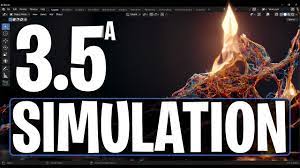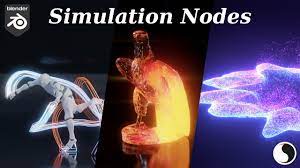Blender, the popular open-source 3D creation software, offers a powerful feature called Simulation Nodes. With Simulation Nodes, artists and animators can bring dynamic and realistic behavior to their 3D scenes, enabling the simulation of physics-based effects, particle systems, cloth dynamics, and more. In this article, we dive into the world of Simulation Nodes Blender, exploring their capabilities, workflows, and creative applications.
- Understanding Simulation Nodes: Simulation Nodes in Blender provide a node-based interface for creating complex simulations and dynamic effects. They offer a versatile set of nodes that can be connected to control and influence various aspects of a scene, such as physics simulations, particle behavior, and object interactions.
- Physics Simulations: Simulation Nodes allow artists to simulate realistic physics interactions within their 3D scenes. This includes rigid body dynamics, soft body simulations, fluid simulations, and smoke simulations. Artists can define the physical properties, forces, and constraints applied to objects, enabling them to create convincing animations and visual effects.
- Particle Systems: Simulation Nodes also offer powerful tools for creating and controlling particle systems. Artists can define the behavior of particles, their emission properties, and their interaction with forces and collisions. This opens up possibilities for creating effects like fire, smoke, explosions, hair, and even abstract motion graphics.
- Cloth and Soft Body Dynamics: Blender’s Simulation Nodes provide robust capabilities for simulating cloth and soft body dynamics. Artists can create realistic cloth simulations, such as flowing garments or flags, by defining properties like stiffness, gravity, and wind forces. Soft body simulations enable the animation of deformable objects, such as jiggling characters or squishy objects.
- Constraints and Interactions: Simulation Nodes allow the creation of constraints to control the behavior of objects and their interactions. Constraints, such as hinges, springs, and constraints between objects, enable the simulation of complex mechanisms, joints, and realistic object dynamics. Artists have fine control over the strength, limits, and properties of these constraints.
- Workflow and Creative Applications: Simulation Nodes in Blender offer a node-based workflow, allowing artists to visualize and control the flow of information and effects within their scenes. Artists can experiment, iterate, and refine their simulations by adjusting parameters, connecting nodes, and observing the results in real time. The creative applications of Simulation Nodes are vast, ranging from realistic visual effects in films and game development to motion graphics and architectural visualization.

Simulation Nodes Blender, provides a powerful and versatile toolkit for creating dynamic and realistic simulations in 3D animation. By leveraging physics-based effects, particle systems, cloth dynamics, and constraints, artists can breathe life into their scenes and enhance the visual storytelling of their projects.
With a node-based interface and real-time feedback, Simulation Nodes Blender, offer artists a flexible and intuitive workflow for fine-tuning their simulations. The creative possibilities are vast, spanning various industries and applications.
Whether you’re an aspiring animator, a visual effects artist, or a game developer, exploring Simulation Nodes in Blender opens up a world of possibilities to create immersive and dynamic 3D animations. So dive in experiment, and let your creativity soar with the power of Simulation Nodes in Blender.
In conclusion, Simulation Nodes in Blender offer a gateway to realistic and dynamic 3D animations. With a versatile set of tools for physics simulations, particle systems, cloth dynamics, and more, artists can bring their scenes to life with captivating visual effects and convincing interactions.
The power of Simulation Nodes lies not only in their functionality but also in their node-based workflow. Artists can seamlessly connect nodes to control and influence various aspects of their simulations, providing them with a flexible and intuitive interface to fine-tune their creations. Real-time feedback allows for experimentation, iteration, and the ability to observe the immediate impact of adjustments.

The creative applications of Simulation Nodes Blender, are vast and diverse. Whether it’s crafting realistic visual effects for films, creating immersive game environments, designing captivating motion graphics, or visualizing architectural concepts, Simulation Nodes empower artists to push the boundaries of their imagination and storytelling.
By harnessing the capabilities of Simulation Nodes, artists can unlock a new level of realism and dynamism in their 3D animations. The ability to simulate physics-based behaviors, control particle systems, and define cloth and soft body dynamics opens up endless possibilities for creating stunning and believable visuals.
As Blender continues to evolve and improve, so too will the capabilities of Simulation Nodes. It is an exciting time for artists and animators, as they can continue to explore and experiment with this powerful feature, pushing the boundaries of what is possible in the realm of 3D animation.
So, whether you are a seasoned professional or an aspiring artist, embrace the world of Simulation Nodes in Blender. Dive into the realm of physics simulations, particle systems, and dynamic interactions, and let your creativity soar as you create awe-inspiring 3D animations that captivate and engage audiences. The possibilities are limitless with Simulation Nodes in Blender by your side.